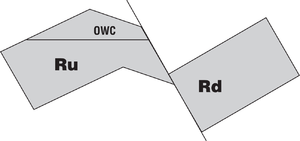Difference between revisions of "Dip-sealing fault"
Jump to navigation
Jump to search
(Initial import) |
Cwhitehurst (talk | contribs) m (added Category:Treatise Handbook 3 using HotCat) |
||
| (8 intermediate revisions by 4 users not shown) | |||
| Line 6: | Line 6: | ||
| part = Predicting the occurrence of oil and gas traps | | part = Predicting the occurrence of oil and gas traps | ||
| chapter = Evaluating top and fault seal | | chapter = Evaluating top and fault seal | ||
| − | | frompg = 10- | + | | frompg = 10-12 |
| − | | topg = 10- | + | | topg = 10-12 |
| author = Grant M. Skerlec | | author = Grant M. Skerlec | ||
| link = http://archives.datapages.com/data/specpubs/beaumont/ch10/ch10.htm | | link = http://archives.datapages.com/data/specpubs/beaumont/ch10/ch10.htm | ||
| Line 14: | Line 14: | ||
| isbn = 0-89181-602-X | | isbn = 0-89181-602-X | ||
}} | }} | ||
| − | A dip-sealing fault traps hydrocarbons against the fault plane. | + | A [[dip]]-sealing fault traps hydrocarbons against the fault plane. |
==Importance of dip-sealing faults== | ==Importance of dip-sealing faults== | ||
| − | |||
| − | [[file:evaluating-top-and-fault-seal_fig10-9.png|thumb|{{figure number| | + | Dip-sealing faults are important because they can create purely fault-dependent [[trap]]s. No independent [[structural closure]] is required for entrapment. Where independent structural closure does exist, as in the figure below, a dip-sealing fault can trap additional volumes of oil against the fault. Dip-sealing faults can trap hundreds of meters of oil without independent closure. In [[:file:evaluating-top-and-fault-seal_fig10-9.png|Figure 1]], both oil and gas are trapped against the fault and have not leaked up the fault zone. |
| + | |||
| + | [[file:evaluating-top-and-fault-seal_fig10-9.png|left|300px|thumb|{{figure number|1}}Oil and gas trapped against the fault and have not leaked up the fault zone.]] | ||
| + | {{clear}} | ||
==See also== | ==See also== | ||
* [[Fault seal behavior]] | * [[Fault seal behavior]] | ||
| − | |||
* [[Cross-leaking faults]] | * [[Cross-leaking faults]] | ||
* [[Cross-sealing faults]] | * [[Cross-sealing faults]] | ||
* [[Dip-leaking faults]] | * [[Dip-leaking faults]] | ||
| − | * [[ | + | * [[Percent fill: controlling factors]] |
==External links== | ==External links== | ||
| Line 36: | Line 37: | ||
[[Category:Predicting the occurrence of oil and gas traps]] | [[Category:Predicting the occurrence of oil and gas traps]] | ||
[[Category:Evaluating top and fault seal]] | [[Category:Evaluating top and fault seal]] | ||
| + | [[Category:Treatise Handbook 3]] | ||
Latest revision as of 17:04, 28 March 2022
| Exploring for Oil and Gas Traps | |

| |
| Series | Treatise in Petroleum Geology |
|---|---|
| Part | Predicting the occurrence of oil and gas traps |
| Chapter | Evaluating top and fault seal |
| Author | Grant M. Skerlec |
| Link | Web page |
| Store | AAPG Store |
A dip-sealing fault traps hydrocarbons against the fault plane.
Importance of dip-sealing faults
Dip-sealing faults are important because they can create purely fault-dependent traps. No independent structural closure is required for entrapment. Where independent structural closure does exist, as in the figure below, a dip-sealing fault can trap additional volumes of oil against the fault. Dip-sealing faults can trap hundreds of meters of oil without independent closure. In Figure 1, both oil and gas are trapped against the fault and have not leaked up the fault zone.
See also
- Fault seal behavior
- Cross-leaking faults
- Cross-sealing faults
- Dip-leaking faults
- Percent fill: controlling factors
